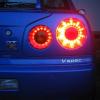Spun Out My R33, A huge leason learnt.
Announcements
-
Similar Content
-
Latest Posts
-
Check the injectors flow evenly, and are actually flowing what you and the ECU think they should be flowing. If it's starting up on starter fluid, you have a fuel issue. Is it possible under cranking your fuel pump is turning off? The harness you replaced, is that the whole engine harness? Do yourself a test, and drop the old harness on and plug it into the Z32 ECU. It's possible they've wired things different. From memory S1 to S2 is different in RB25 and you may have a wrong loom
-
I haven’t pulled the injectors to watch them spray yet but they are clicking from the cas and all of the spark plugs are wet with fuel. I’ve thought the cylinders were being flooded from the beginning and was hoping fuel pressure would fix it. Tonight I am going to pull the rail and watch the injectors spray. Don’t know how to test/diagnose if the plugs are firing in correct sequence but that should be a timing thing and as far as timing goes my car still has the half moon for the cas can only install it 1 way. And my mechanical timing is 100% correct I posted photos above. Confirmed with the balancer on and off.
-
I checked spark on all cylinders and they all visually have spark with the plug pulled and grounded, but plug 1 is the only one that fouled. This was a running swap that blew up and was rebuilt by a machine shop, put a new wiring specialties harness and did all gaskets, studs, and bolts while it was out. compression is 135-150 across all cylinders. Aside from that from my understanding with the z32 ecu and maf the car should start regardless. The wiring for TPS and the dual 02 sensor/ dual knock sensor stuff shouldn’t actually stop the car from starting or even running well, (just slightly rich) they just give fault codes. Car supposedly is supposed to start as long as you have z32 afm and ecu with the nistune base map and that’s info coming from a well known and trusted tuner who does a lot with SR/RB (Rsenthalpy). After more trouble shooting today where I’m at right now is that the cas is sending signal to the injectors they click while spinning the rotor, Fuel pressure is now set at 43psi, all cylinders have good compression and all of the plugs looked great (just wet with fuel) except for cylinder 1 which was very black (cylinder 1 has 150psi compression). all of the coils generate spark if pulled out and grounded out on the head. On the fuel pump car just pops into the exhaust. On starting fluid car will fire off. Hard to tell if all cylinders are firing off but definitley a couple. sounds like all of them but it’s only for 3-5 seconds hard to tell.
-
By DraftySquash · Posted
Final update!!! Got the front bar fitted and sprayed and all sorted now. My cutouts worked great and the indicators aren’t just falling off. 😂








Recommended Posts
Create an account or sign in to comment
You need to be a member in order to leave a comment
Create an account
Sign up for a new account in our community. It's easy!
Register a new accountSign in
Already have an account? Sign in here.
Sign In Now